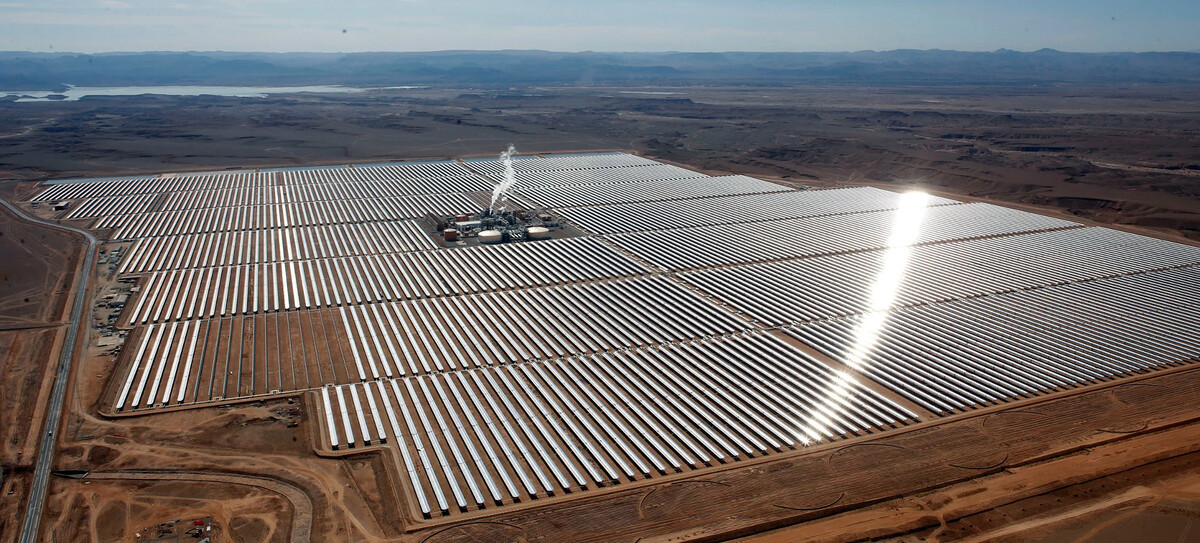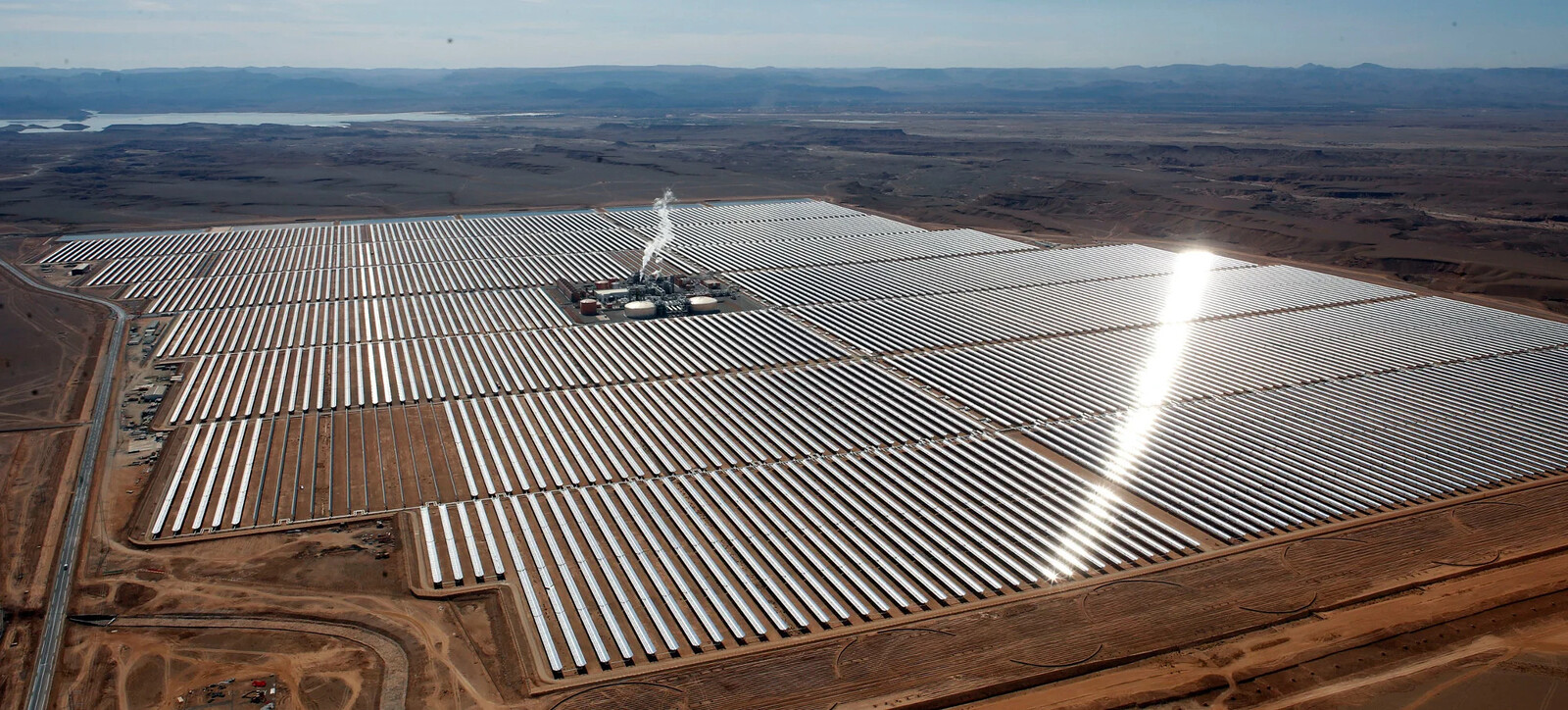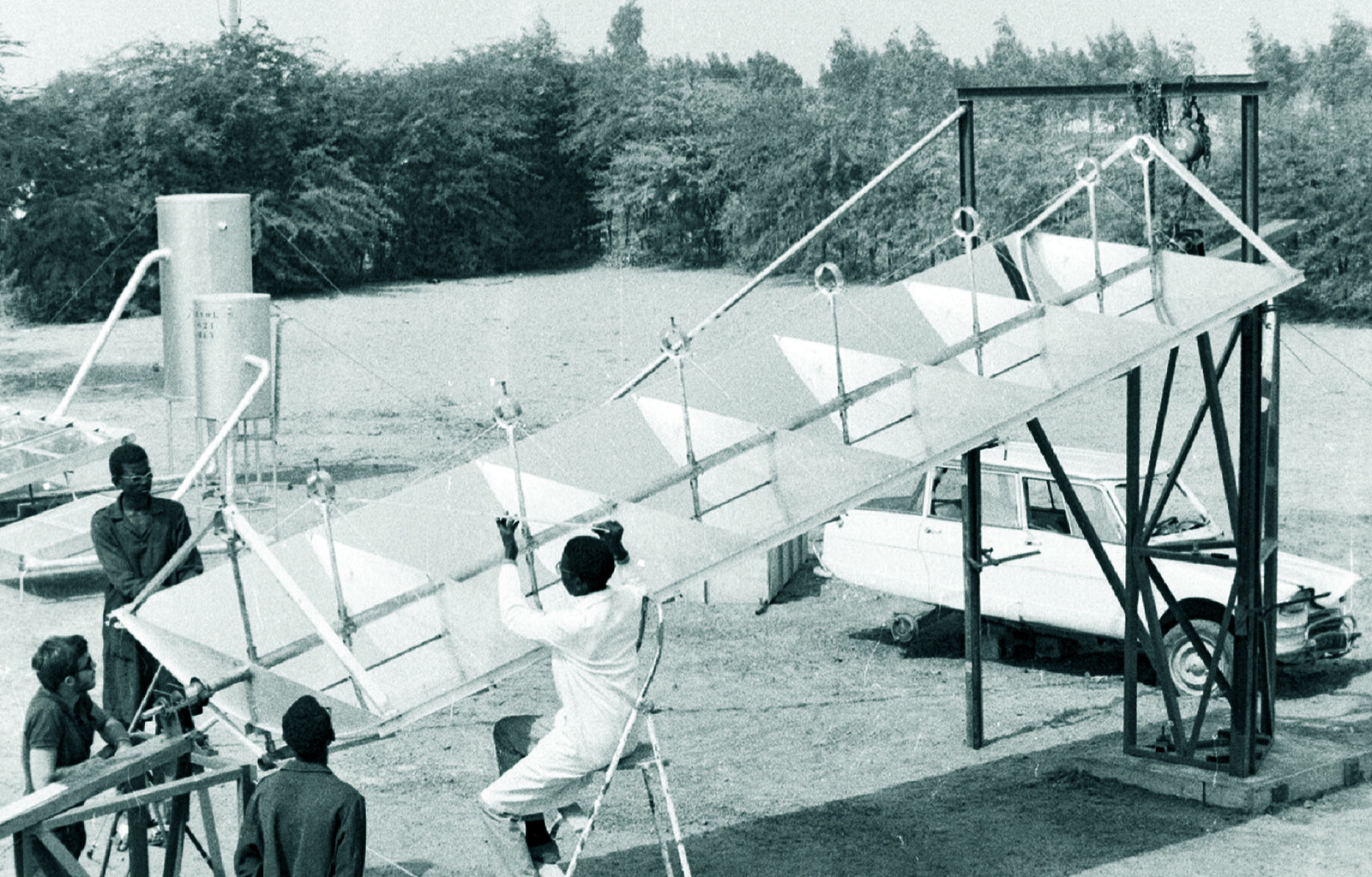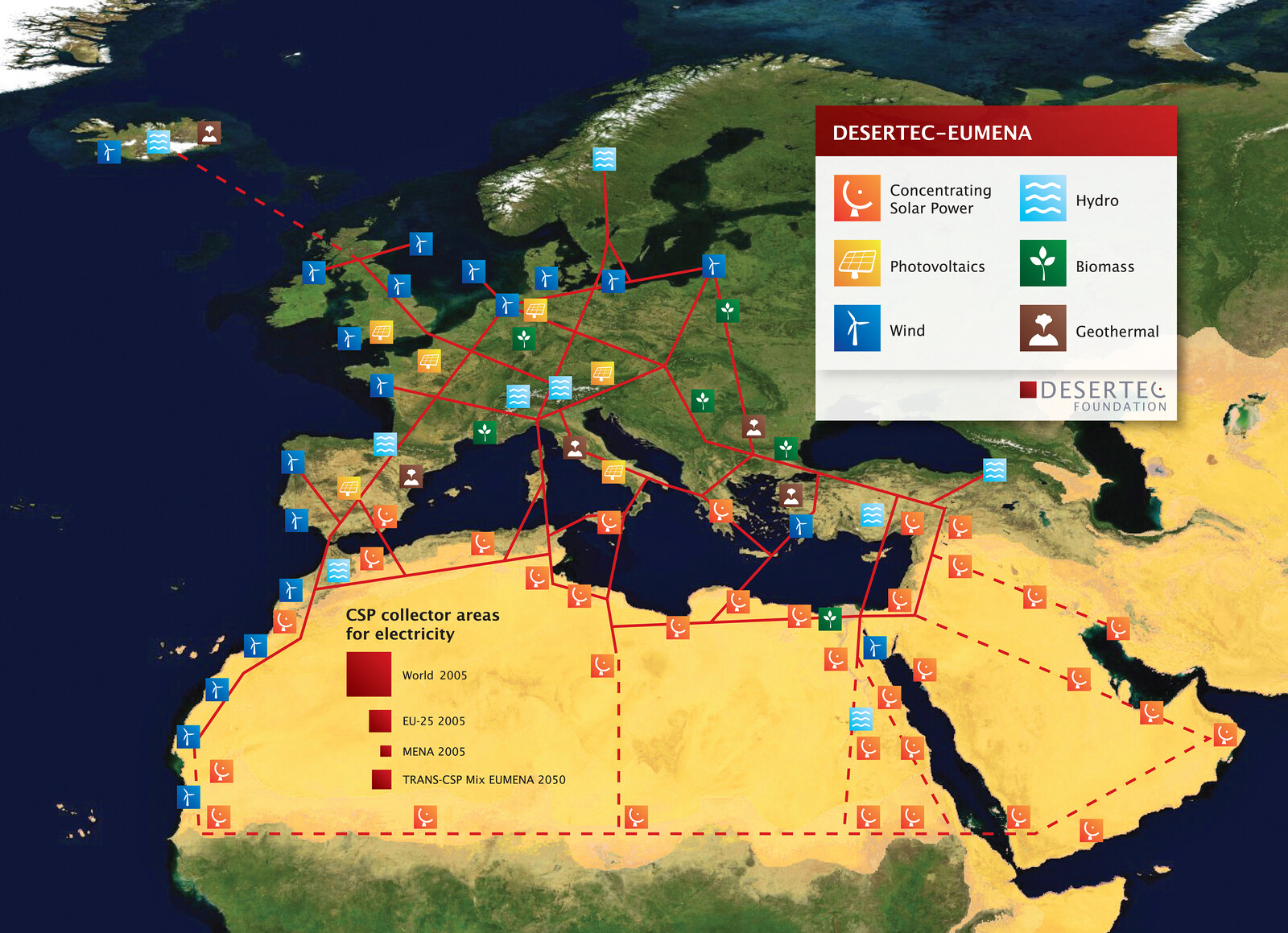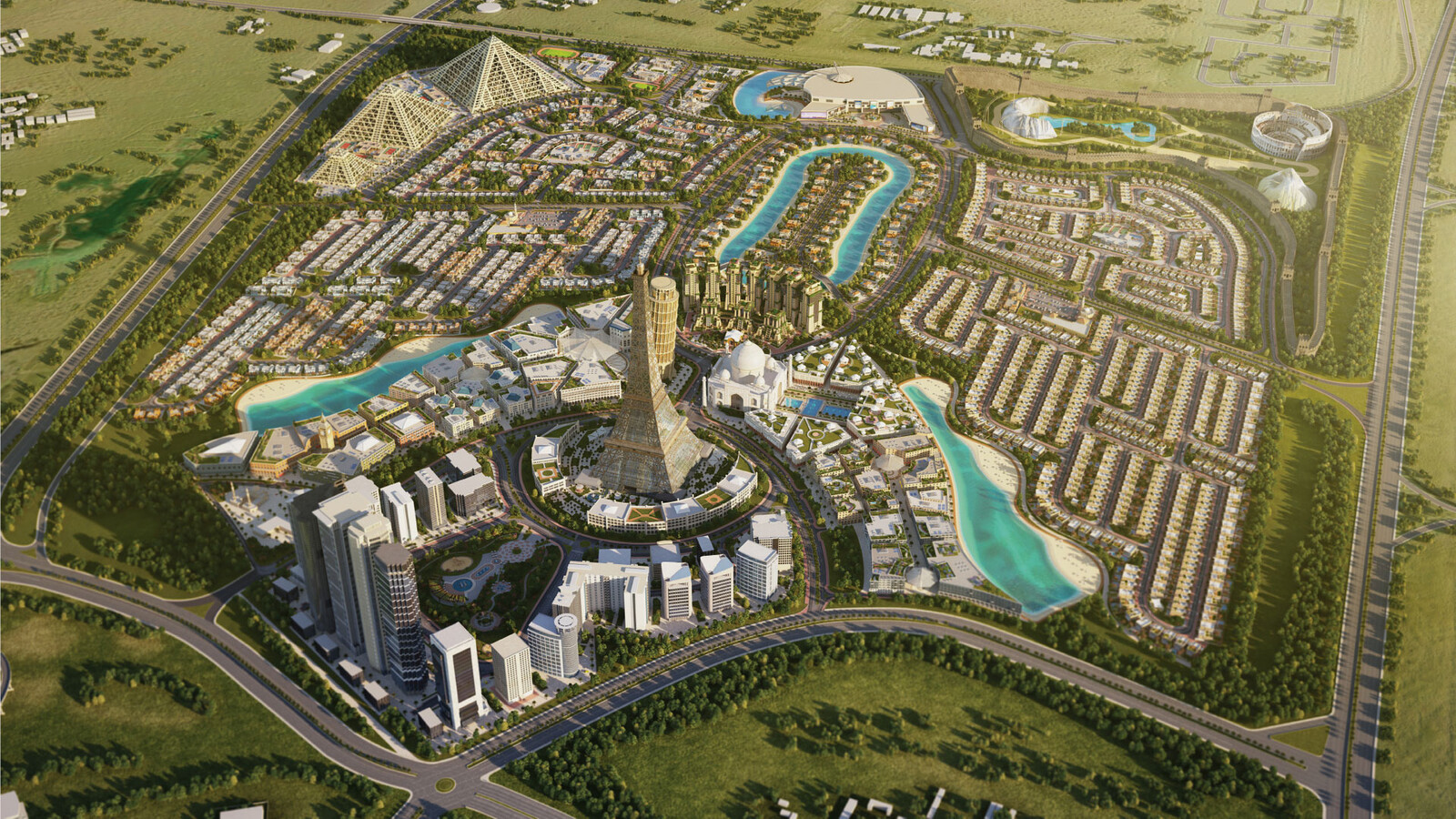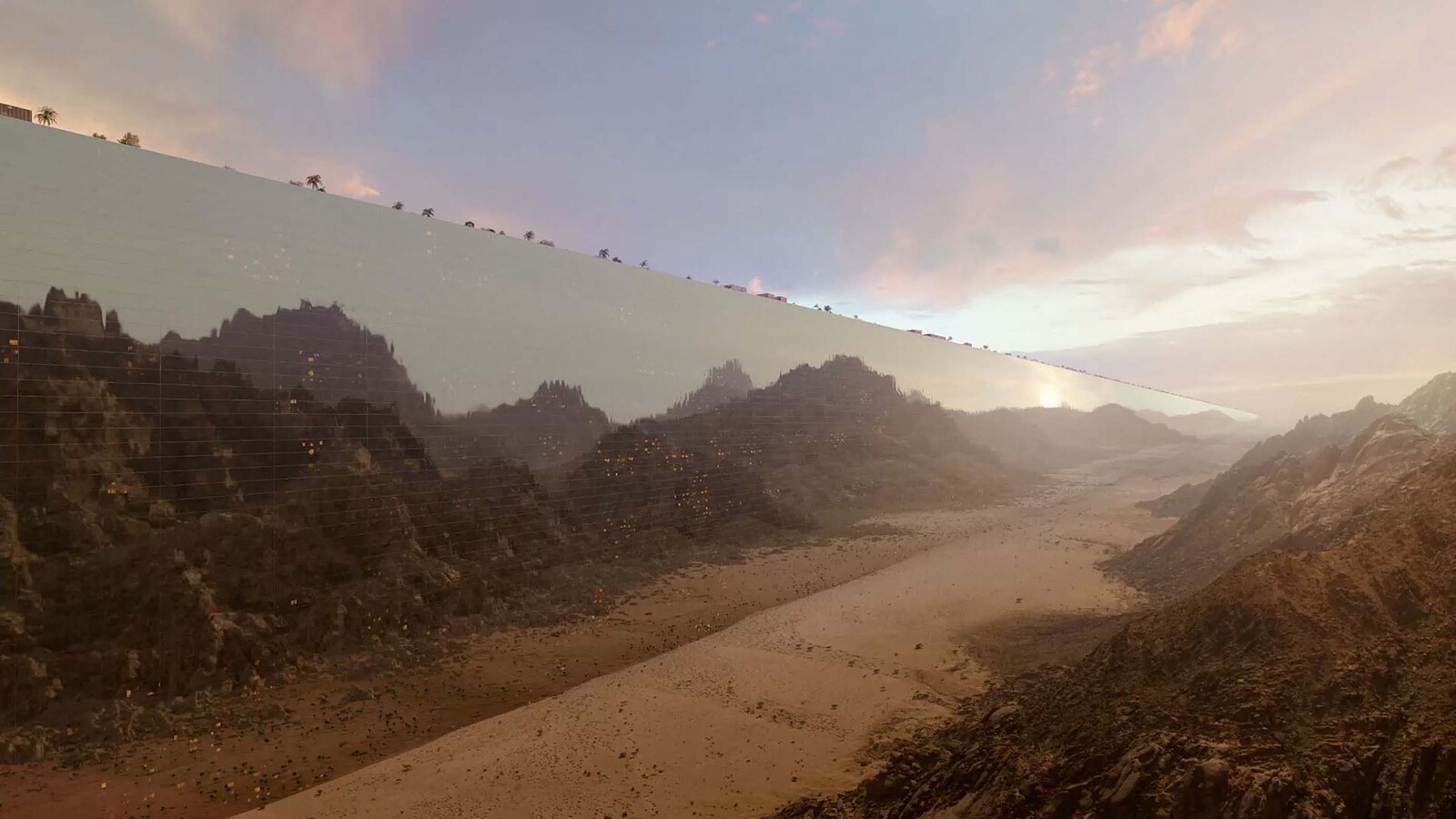In February 2016, the solar power station of Ouarzazate was inaugurated in Morocco, on the north-western edges of the Sahara. In an irregular rocky landscape covered by brown dust, hundreds of bright strips emerged and imposed their strict geometrical order. They are semi-parabolic mirrors which automatically rotate during the day to reflect the sun’s rays onto a thin tube placed at the center of the machine. There, a liquid is warmed up and collected at the core of the complex, where it fuels a turbine to produce electricity. Ouarzazate’s impressive installation was celebrated by the media as the first step of a highly ambitious project named Desertec. Initiated by a consortium of German think tanks and big companies, Desertec is presented as a project capable of revolutionizing energy production in the world. The idea is simple: harnessing a fraction of the solar energy received by the world’s largest desert would be enough to cover the needs of industrial societies.1
Launched in 2009 and presented as a key endeavor for a low-carbon future, Desertec and the beginning of its realization through the Ouarzazate solar power station revive ancient ideas and evoke old attempts of harvesting the sun. Long seen as vast territories unsuited for human occupation and unproductive, deserts began to be considered as potential resource suppliers in the industrial age, particularly of energy. The greater the energy needs of industrial societies were, the more deserts were looked at with greedy eyes, and projects were undertaken to make them profitable.2 This has particularly been the case with the Sahara, which was gradually conquered and occupied mainly by British, French, and Italian colonizers starting in the early nineteenth century. Since then, a series of attempts to harness the sun’s rays, often presented as the wealth of the desert, have emerged and continue to shape our imaginaries. An inquiry into the longue durée of solar projects in the Sahara is telling of our relationships with the desert. It shows how harnessing the sun’s rays has been tied to the notion of extractivism, while questioning our responsibilities towards the production and consumption of energy in the time of climate change.
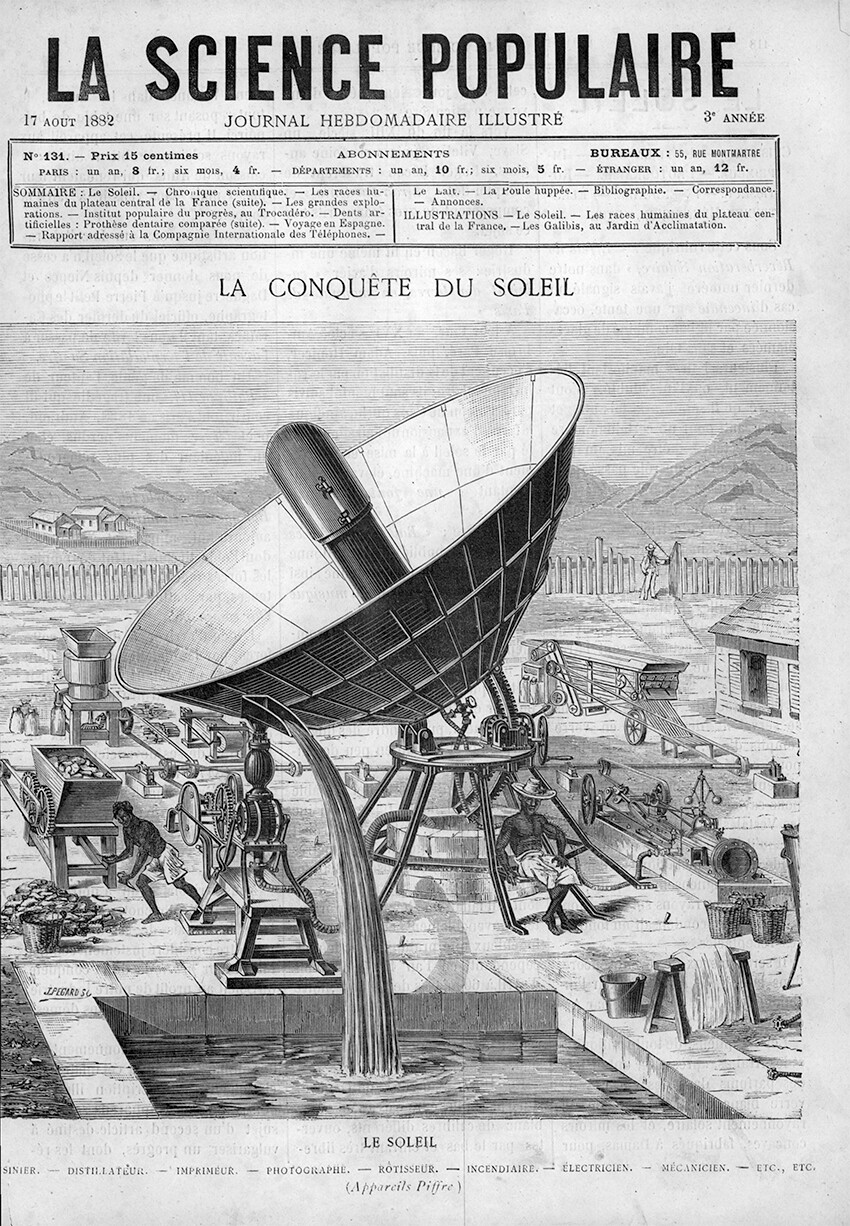

Augustin Mouchot’s solar engine depicted in La Science populaire, n° 131, August 17, 1882.
Colonial Energy
If coal is considered to be the key energy of the nineteenth century, the growth of its use was already paralleled by concerns regarding its depletion. The vast quantities of coal extracted in the mines of England, continental Europe, and gradually other parts of the world fueled the spreading of railroads, steam engines, as well as domestic heating. But they also raised alarms concerning the dependency placed on this finite source of energy, thereby stimulating research into alternative energies. Among them, the sun was seen as a provider of a temporally infinite and spatially universal energy, even capable of replacing coal in various instances, as argued by Augustin Mouchot in the second half of the nineteenth century. A math teacher at Tours high school in France, Mouchot invented a series of devices to concentrate the sun’s rays by means of mirrors targeted onto a glass jacket where water was running. There, the water was boiled and transformed into steam which could be used directly for cooking or to power a steam engine, and thus converted into mechanical force. Mouchot promoted his ideas throughout France where they received great attention from the political and scientific authorities, but soon he turned his eyes towards the Sahara. In his 1869 book La chaleur solaire et ses applications industrielles (Solar Heat and its Industrial Applications), he pointed at the sunniest regions of the world as the most suited to develop solar applications:
In a distant future, but which we can already calculate, industry will no longer find in Europe the resources which fuel its prodigious growth. What will it do then? Will it stick to the power of the wind, of the rivers, of the animals, of the machines fueled by coal? Or will it be forced, in order to harness the sun’s rays far away, to emigrate in the regions where this energy is abundant?
—Augustin Mouchot3
In Mouchot’s view, solar energy was the ideal way of industrializing the desert. The unfertile and unproductive lands of the Sahara, almost deprived of coal resources, could play a role in the production of wealth. Mouchot promoted his solar concentrators as a means to develop modern agriculture by providing energy to pump water for irrigation, as well as to transform minerals and operate factories. The French government saw his ideas as a way of both strengthening national pride based on the development of new technologies and reinforcing its presence in its North African colonies, even possibly making them profitable for the metropolis. Mouchot received public funding in 1877 to go on a mission in Algeria, then a French colony, to test and improve his devices that were also used by industrialists alongside soldiers. His solar machines were showcased in a series of exhibitions where they received much public attention, including in the Algerian section of Paris Great Exhibition in 1878.
Despite the interest he was able to garner around solar energy, Mouchot eventually abandoned his research. Government commissions considered his devices to be economically uncompetitive and difficult to use compared to coal, whose extraction and dissemination was continuing to expand.4 But the idea of using solar energy to industrialize the desert kept being promoted by various experts. Among them was Charles Tellier, an engineer specialized in cold food storage, who published La conquête pacifique de l’Afrique occidentale par le soleil (The Pacific Conquest of West Africa by the Sun) in 1890.5 In this enthusiastic manifesto, Tellier called for the construction of a trans-Saharan railway to connect the French colonial territories on the coasts of Morocco, Algeria, and Tunisia to those on the Gulf of Guinea in the south, going straight through the desert for thousands of kilometers.
Drawing on Mouchot’s ideas, Tellier argued that the sun could provide the mechanical force necessary to build and operate this railway, while also pumping water and fueling agricultural and industrial machines in hundreds of new settlements created along its route. The arid lands would thereby be turned into populous and productive territories, which would provide the metropolis with raw materials and constitute a new colonial market. In Tellier’s own words, the use of the sun’s energy was the means of a “peaceful conquest” of the Sahara, a way to exploit the desert’s energy and develop infrastructures and industries for the main benefit of the colonizer. He concluded by imagining that, with this trans-Saharan railway, “immense swaths of lands, i.e. the whole West Africa, would be connected to Algeria and thereby submitted to France’s industrial domination.”6
While Tellier’s project also proved unsuccessful, another attempt was soon made on the British-ruled side of the Sahara. Frank Shuman, an American engineer initially specialized in the production of glass, went into partnership with British investors to experiment with a solar device he had invented and tested in his hometown of Philadelphia, Pennsylvania. Just like Mouchot and Tellier, his goal was to use the sun’s energy to power steam engines for pumping water and turning arid territories into green lands. Shuman and his British partners chose the farming community of Meadi, a village south of Cairo, Egypt, to build their solar station, which was completed in 1913. It consisted of semi-parabolic mirrors concentrating the sun’s rays on tubes where water was transformed into steam. While the Meadi installation was based on principles similar to the previous experiments, its scale was unprecedented. The five solar collectors were more than sixty meters long and could pump thousands of liters of water per hour from the Nile. However, the Meadi experiment was caught up by the outbreak of World War I, which led to the dissolution of the partnership, while the engineers in charge of the installation went back to their home countries.7
Beyond local experiments of solar machines, the use of other renewable energy sources was envisioned by Europeans at a much larger scale. The paradigmatic project of this was Herman Sörgel’s Atlantropa, developed between the late 1920s and the 1950s. A German architect, Sörgel promoted the idea of uniting Europe and Africa into a single continent. Named Atlantropa, or sometimes Eurafrika, it was meant to be large and powerful enough to compete with the other two “A’s”: America and Asia. To realize his vision, Sörgel proposed to transform the main divide between Europe and Africa, the Mediterranean Sea, into a huge industrial and agricultural installation. Dams were to be erected on both the western and eastern edges of the sea to create a difference in water levels. Electricity would thereby be generated via large hydropower plants, while lands would be reclaimed from water after the lowering of the sea. Electric wires as well as new railways would also cross the sea, including two trans-Saharan railways connecting London to Dakar and Berlin to Cape Town. For North Africa, Sörgel revived the old idea of creating inner seas in portions of the Sahara that are below sea level. Water from the Mediterranean would be directed inland, producing electricity along the way by falling, and would irrigate vast swaths of arid lands, so that “Die Wüste wird fruchtbar” (“The desert becomes fertile”), as a caption to Atlantropa’s synthetic map indicates.
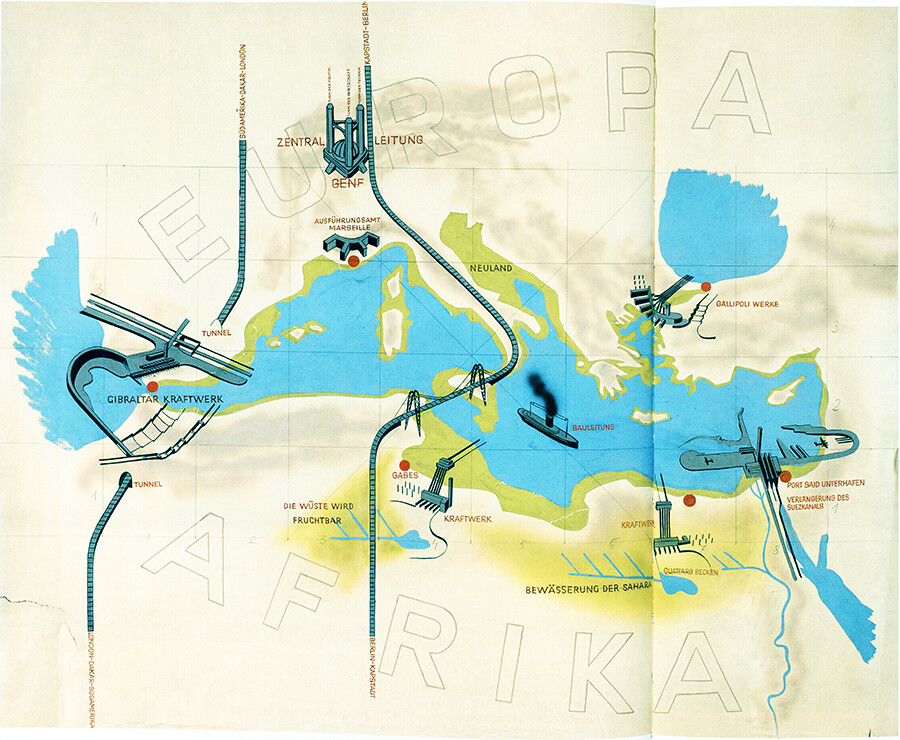

Herman Sörgel and Erik Theodor Lässig, map of Atlantropa, 1932.
Sörgel promoted Atlantropa as a project that was not only able to develop Europe’s economy, but also bring peace among its nations that had been divided by successive wars, uniting them around a common grand endeavor. But despite this peaceful claim, Atlantropa was underpinned by a settler colonial and extractivist agenda, strongly influenced by the ideology of Lebensraum, or Germany’s desire to conquer a resourceful “vital space” so as to strengthen its power. The project was to be entirely led and operated by European elites, and all of its facilities were designed by German architects. Among them were Peter Behrens, who designed the locks and a 400-meter-high tower which was to crown the thirty-five-kilometer dam that would span and close the Gibraltar Strait, and Erich Mendelsohn, who planned the development of Palestine on lands reclaimed from the sea. Moreover, the resources generated by Atlantropa were largely meant to be directed towards Europe. The gigantic dams were to cover all energy needs of the continent, while food production, including in the newly fertile Sahara, was to feed the European population.8 For Mouchot, Tellier, and Sörgel, with solar as with hydropower, the idea was the same: to use the energy and resources available in the North African desert to serve the needs of the European empires.
Postcolonial Continuities
Like his predecessors, Sörgel’s vision did not come to fruition. Nevertheless, it continued to fuel the idea that the desert could be industrialized via the use of new energy sources, and especially solar. The promises of the sun’s rays attracted much attention during World War II, when energy shortages led to the search for alternative sources. In France, engineers advocated the use of solar energy to replace coal and oil, and again designated the Sahara as the perfect place to experiment with it. One of them, chemist and engineer Félix Trombe, became the main promoter of solar energy in postwar France. Inspired by Mouchot, Trombe began to experiment with solar furnaces to melt the refractory metals—raw materials extremely resistant to heat—that he was studying. Soon, he advocated for the construction of large solar furnaces in North Africa to transform and purify ores extracted there, such as manganese. In parallel with these industrial applications, Trombe undertook research into the domestic uses of solar energy. He developed a series of more simple devices to purify water, generate cold, and alternatively produce warm and fresh air on façades to air-condition dwellings in the very contrasting climate of the desert, which combines extreme high daytime and low nighttime temperatures.9
In Trombe’s view, the Sahara was a laboratory where to experiment with solar applications before their worldwide dissemination. Like contemporary neo-Malthusian thinkers, he worried that the increasing use of fossil fuels was a threat to the continuation of industrial development and economic growth. According to him, these finite resources were being depleted at an ever faster pace and would inevitably be depleted. In the end, renewables sources, and above all solar energy, would have to take over. But the material infrastructures of industrial societies were so dependent on fossil fuels that they were not ready to adopt solar energy. Therefore, Trombe saw the arid lands as the perfect place to develop solar applications. In the late 1950s, he tested his air-conditioning devices in the military base of Colomb-Béchar, in the Algerian Sahara, and planned the construction of giant greenhouses and solar furnaces in the desert. As may seem paradoxical in retrospect, the use of solar energy was presented as a key component of the French extractivist policy in the desert. The direct use of the sun’s energy in places remote from existing cities and infrastructures was to fuel a variety of needs in the new industrial bases built for the extraction of oil and natural gas. But Trombe’s endeavors were stopped by the conclusion of the Algerian war of independence, when France withdrew from North Africa in 1962.10
While again Trombe’s research was led from the West and embedded in a colonialist agenda, a dissenting voice emerged in the history of solar energy use in the African desert. It came from Nigerien physicist Abdou Moumouni, who was trained in Senegal and France before he established a research center in 1969, the Office nigérien de l’énergie solaire (Nigerien Office for Solar Energy), in his home country. Moumouni claimed that “Formerly colonized and currently underdeveloped countries, especially those of sub-Saharan Africa, shall not and cannot have the same point of view nor the same goals towards the use of solar energy than developed countries.”11 He denounced the fact that Westerners were first and foremost driven by “the conquest of new markets” for their industries.12 They were developing solar applications to their own purpose, with few considerations for the needs of local populations. Moumouni argued that solar devices should be made of locally produced and easy to assemble materials, and be dedicated primarily to pumping water and producing heat for domestic purposes in rural communities located throughout the Sahel’s semi-arid climate. This development of solar applications in West Africa, based on knowledge developed in the West, but adapted to and controlled by local populations, is an early example of what was to be theorized as “appropriate technologies” in the 1970s by thinkers such as Ernst Fritz Schumacher and Ivan Illich.13
But Moumouni remained a marginal voice in the quest to use solar energy in the African desert. Despite his claims, the path that has been followed in development policies since then have kept far from the appropriate technologies’ ideal, i.e. technologies that are simple, easy to implement and understand, adapted to the needs of local community, and generally small scale. On the contrary, and especially in the case of solar energy, development programs have often continued to rely on technologies imported from the West, and more recently from China, perpetuating Africa’s technological, scientific, and economic dependency in the postcolonial period. This is especially the case with the conversion of solar energy into electrical power, which has gained importance since the 1990s with the development of photovoltaic panels. While this technology can allow decentralized uses and be used to power local communities, its components are imported from very distant locations, rely themselves on damaging extractive mining industries, and have a relatively short lifespan.
Energetic Irresponsibility
Desertec is nothing but the most recent avatar of this fraught relationship between Africa and Europe, and a new episode in the longue durée history of solar energy in the Sahara. The project is an initiative of two think tanks, Sahara Green and the German branch of the Club of Rome. Its main investors were initially big German companies including Deutsche Bank, Munich Re, EON, Siemens, and RWE, who were later joined by development institutions such as the World Bank and the Agence Française de Développement (AFD). The project consists of building large concentrating solar power plants in the Sahara, alongside trans-mediterranean high-voltage lines, to feed the energy needs of Europe and contribute to the domestic electricity consumption of the countries where the plants are to be built. As the Desertec map shows, a large energy grid would thereby be created across both sides of the Mediterranean Sea, and potentially include other sources of renewable energy. This time, the new region that would result from this endeavor is not named Atlantropa or Eurafrika as with Sörgel a century ago, but called EUMENA, standing for the connection between Europe, the Middle East, and North Africa.
In many ways, and not only by its semantic, Desertec appears as the continuation of the previous attempts to harness the sun’s rays in the Sahara. The technology of concentrating solar power with parabolic mirrors is largely based on Mouchot’s steam machines, Shuman’s installation in Egypt, as well as Trombe’s solar furnaces, although the scale and the components of the systems are now different. The idea of using solar energy to turn arid lands into productive lands is also still present in Desertec, with the difference being that this is now achieved by generating electricity, and not irrigation or other solar applications. But above all, the relationship between Europe and the Sahara is haunted by the same specter. This European led initiative still considers the African desert as a land to extract the wealth it demands to fuel its economic growth, with few considerations for local populations and their environment. Even if Desertec claims to be profitable for North African and Middle Eastern countries, in line with developmental discourses, it has been accused by many of being neo-colonial.14
In this sense, Desertec and attempts of its kind can be seen as particular forms of extractivism. Generally used to characterize processes of extracting material resources from the ground, be it metals, hydrocarbons, or other raw materials, with high impacts on local communities and the environment, and to the benefit of wealthy countries and companies located elsewhere, this concept can find its equivalent with the capture and exploitation of the sun’s energy, in what we can call “solar extractivism.” In the Sahara’s case, vast areas of desert are covered with solar panels with the goal of transferring the energy produced to very distant regions of consumption, without much consideration for the places where these plants are built. Matter is not removed from the earth and does not cause the destruction of natural sites per se, but the sun’s energy is harnessed by artificializing and occupying vast territories to the benefit of the most economically and politically powerful parts of the world. As environmentalist activist Naomi Klein argues, extractivism is linked to the idea of sacrifice and imperialism:
Extractivism is also directly connected to the notion of sacrifice zones—places that, to their extractors, somehow don’t count and therefore can be poisoned, drained, or otherwise destroyed, for the supposed greater good of economic progress. This toxic idea has always been intimately tied to imperialism, with disposable peripheries being harnessed to feed a glittering center, and it is bound up too with notions of racial superiority, because in order to have sacrifice zones, you need to have people and cultures who count so little that they are considered deserving of sacrifice. Extractivism ran rampant under colonialism because relating to the world as a frontier of conquest—rather than as home—fosters this particular brand of irresponsibility.
—Naomi Klein 15
The irresponsibility pointed out by Klein is key in this issue. Of course, with growing concerns over climate change, the context is now different than with the previous attempts to harness solar energy in the Sahara. Initiatives such as Desertec are presented as key steps to achieve a rapid “energy transition” by replacing fossil fuels by solar energy. But this “transition” must not be operated at any cost and should avoid entrenching and exacerbating long-standing problems. Rather, energy and climate issues should be considered within a broader framework. Indeed, the West’s constant desire to extract solar energy from the desert should not only be a question of energy production, but also of its consumption. By delocalizing the production of energy to distant places, far from our sight, with few considerations for its multiple local impacts, we tend to disregard the concrete consequences of our daily and apparently benign actions, almost all of which involve the consumption of energy, and so to a far greater extent than in lower income countries of the Global South. Underneath the fields of solar panels with which the West intends to cover the Sahara lies the carefreeness of our ways of life and the reassuring idea that they are becoming “greener” without fundamentally changing. But places like deserts and the populations that inhabit them should be considered for themselves, with respect for their ecologies and ontologies, and not be the subject of new conquests that justify our own energetic irresponsibility.
Pierre le Hir and Marie de Vergès, “Quand l’Europe se chauffera au soleil du Sahara,” Le Monde, July 13, 2009.
Diana K. Davis, The Arid Lands: History, Power, Knowledge, Cambridge (Mass.), MIT Press, 2016.
Augustin Mouchot, La chaleur solaire et ses applications industrielles, Paris, Gauthier-Villars, 1869, p. 215.
François Jarrige, “‘Mettre le soleil en bouteille’: les appareils de Mouchot et l’imaginaire solaire au début de la Troisième République”, Romantisme, n° 150, avril 2010, p. 85-96.
Charles Tellier, La conquête pacifique de l’Afrique occidentale par le soleil, Paris, J. Michelet, 1890.
Ibid., p. 103.
John Perlin, Let It Shine: The 6,000-Year Story of Solar Energy, Novato, New World Library, 2013, p. 128-142.
Wolfgang Voigt, Atlantropa. Weltbauen am Mittelmeer. Ein Architektentraum der Moderne, Hamburg, Dölling und Galitz, 1998.
Paul Bouet, “Le mur Trombe,” in François Jarrige and Alexis Vrignon (eds.), Face à la puissance. Une histoire des énergies alternatives à l’âge industriel, Paris, La Découverte, 2020, p. 249-263.
Paul Bouet, “A Silent Graph: Tracing the Algerian Past of French Solar Experiments,” Architecture Beyond Europe Journal, n° 18, 2021.
Abdou Moumouni, “L’énergie solaire dans les pays africains,” Présence africaine, n° 2, 1964, p. 96-126, quote p. 115.
Ibid.
Ernst Fritz Schumacher, Small is Beautiful: A Study of Economics as if People Mattered, London, Blond & Briggs, 1973; Ivan Illich, Tools for Conviviality, New York, Harper and Row, 1973.
Thomas Schmitt, “(Why) did Desertec Fail? An Interim Analysis of a Large-Scale Renewable Energy Infrastructure Project from a Social Studies of Technology Perspective”, Local Environment, vol. 23, n° 7, May 2018. Like its predecessors, Desertec seems to end up being a failure. The many critics it attracted and the major technical and political obstacles it faced prevented its realization, except for punctual realizations, like the Ouarzazate solar power plant, which was decided by Morocco. But the idea of covering the Sahara with solar panels continue to be promoted. See for instance Filip Filipov, “Solar Panels in the Sahara Desert about Environmentally Friendly Energy for the World,” Conference on the Future of Europe, accessed August 25, 2022, ➝.
Naomi Klein, This Changes Everything: Capitalism vs the Climate, New York, Simon & Schuster, 2014, p. 226. Klein adds: “These ideas predate industrial-scale extraction of fossil fuels. And yet the ability to harness the power of coal to power factories and ships is what, more than any single other factor, enabled these dangerous ideas to conquer the world. It’s a history worth exploring in more depth, because it goes a long way toward explaining how the climate crisis challenges not only capitalism but the underlying civilizational narratives about endless growth and progress within which we are all, in one way or another, still trapped.”
Horizons is a collaboration between e-flux Architecture and the International Architecture Biennale Rotterdam.
